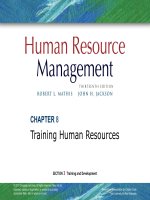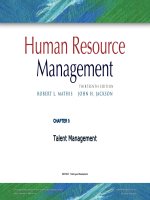Human resrouce management 12th mathis jacson chapter 004
Bạn đang xem bản rút gọn của tài liệu. Xem và tải ngay bản đầy đủ của tài liệu tại đây (2.14 MB, 39 trang )
CHAPTER 4
Legal Framework of
Equal Employment
© 2008 Thomson/South-Western All rights reserved.
PowerPoint Presentation by Charlie Cook
The University of West Alabama
Chapter
Chapter Objectives
Objectives
After you have read this chapter, you should be able to:
■ Explain four basic EEO concepts.
■ Describe key provisions in Title VII of the Civil Rights
Acts of 1964 and 1991.
■ Indicate important requirements of four other key EEOrelated laws.
■ Discuss the two general approaches for complying with
the 1978 Uniform Guidelines on Employee Selection
Procedures.
■ Identify typical EEO enforcement and compliance
requirements.
© 2008
Thomson/SouthWestern. All rights reserved.
4–2
Nature of Equal Employment Opportunity
• Equal Employment Opportunity (EEO)
The concept that all individuals should have equal
treatment in all employment-related actions.
• Discrimination
“Recognizing differences among items or people.”
• Protected Class
Individuals within a group identified for protection
under equal employment laws and regulation.
• Race, ethnic origin, color • Sex/gender • Age
• Disability • Military experience • Religion
• Marital status • Sexual orientation
© 2008 Thomson/SouthWestern. All rights reserved.
4–3
FIGURE 4-1
Illegal Employment Discrimination
© 2008 Thomson/SouthWestern. All rights reserved.
4–4
Nature of EEO (cont’d)
• Disparate Treatment
Occurs in employment-related situations when either:
Different standards are used to judge different
individuals, or the same standard is used, but it is
not related to the individuals’ jobs
The outcome of the employer’s actions, not the intent,
is considered by the regulatory agencies or courts
when deciding whether or not illegal discrimination
has occurred.
© 2008 Thomson/SouthWestern. All rights reserved.
4–5
Nature of EEO (cont’d)
• Disparate Impact
Occurs when substantial underrepresentation of
protected-class members results from employment
decisions that work to their disadvantage.
Griggs vs. Duke Power (1971) decision:
1.
Lack of intent to discriminate is no employer
defense if discrimination occurs.
2.
The employer has the burden of proof in
proving that an employment requirement is a
job-related “business necessity.”
© 2008 Thomson/SouthWestern. All rights reserved.
4–6
FIGURE 4-2
EEO Concepts
© 2008 Thomson/SouthWestern. All rights reserved.
4–7
Burden of Proof
• McDonnell-Douglas v. Green
The court ruled that a prima facie (preliminary) case
of employment discrimination exists by showing:
1.
The person is a member of a protected group.
2.
The person applied for and was qualified for a
job but was rejected.
3.
The employer continued to seek other
applicants after the rejection occurred.
Once a court rules that a prima facie case has been
made, the burden of proof shifts to the employer.
© 2008 Thomson/SouthWestern. All rights reserved.
4–8
Progressing Toward EEO
• Equal Employment
Employment that is not affected by illegal
discrimination.
• Blind to differences
Differences among people should be ignored and
everyone should be treated equally.
• Affirmative Action
Employers are urged to hire groups of people based
on their race, age, gender, or national origin to make
up for historical discrimination.
© 2008 Thomson/SouthWestern. All rights reserved.
4–9
FIGURE 4-3a
Major Federal Equal Employment Opportunity Laws and Regulations
© 2008 Thomson/SouthWestern. All rights reserved.
4–10
FIGURE 4-3b
Major Federal Equal Employment Opportunity Laws and Regulations
© 2008 Thomson/SouthWestern. All rights reserved.
4–11
FIGURE 4-3c
Major Federal Equal Employment Opportunity Laws and Regulations
© 2008 Thomson/SouthWestern. All rights reserved.
4–12
Sex/Gender Discrimination
• Pay Equity (Comparable Worth)
The concept that pay for jobs requiring comparable
levels of knowledge, skill, and ability should be paid
similarity, even if actual duties differ significantly.
Arises from the continuing gap between the earnings
of women and men.
Courts have consistently ruled against the concept.
© 2008 Thomson/SouthWestern. All rights reserved.
4–13
Sex/Gender Discrimination (cont’d)
• Sexual Harassment
Actions that are sexually directed, are unwanted, and
subject the worker to adverse employment conditions
or create a hostile work environment.
Can occur between a boss and a subordinate, among
co-workers, and when non-employees have business
contacts with employees.
© 2008 Thomson/SouthWestern. All rights reserved.
4–14
Americans with Disabilities Act (ADA)
• Disabled Person
Someone who has a physical or mental impairment
that substantially limits life activities, who has a
record of such impairment, or who is regarded as
having such an impairment.
• Who is disabled?
Mitigation means and methods
Mental disabilities (e.g., depression)
Life-threatening illnesses (e.g., AIDS and HIV)
Genetic bias regulations
© 2008 Thomson/SouthWestern. All rights reserved.
4–15
ADA and Job Requirements
Reasonable Accommodation
Essential Job Functions
Undue Hardship
Fundamental job duties of
the employment position
that an individual with a
disability holds or desires.
Significant difficulty or
expense imposed on an
employer in making an
accommodation for
individuals with disabilities.
© 2008 Thomson/SouthWestern. All rights reserved.
4–16
FIGURE 4-4
Most Frequent ADA Disabilities Cited
© 2008 Thomson/SouthWestern. All rights reserved.
4–17
Source: Based on data from U.S. Equal Employment Opportunity Commission, 1992–2005; see www.eeoc.gov for details.
Employment Discrimination Acts
• Age Discrimination in Employment (ADEA)
Prohibits employment discrimination against all
individuals age 40 or older working for employers
having 20 or more workers.
Does not apply if age is a job-related qualification
(BFOQ).
• Older Workers Benefit Protection Act (OWBPA)
An amendment to the ADEA aimed at protecting
employees when they sign liability waivers for age
discrimination in exchange for severance packages.
© 2008 Thomson/SouthWestern. All rights reserved.
4–18
Immigration Reform and Control Act (IRCA)
• Immigration Reform and Control Act (IRCA)
Prohibits employment discrimination against persons
legally permitted to work in the United States.
Requires employers to document (I-9 form) eligibility
for employment.
Provides penalties for knowingly
employing illegal workers.
© 2008 Thomson/SouthWestern. All rights reserved.
4–19
Discrimination Laws and Regulations
• Religious Discrimination
Discrimination is illegal unless religion is a bona fide
occupational qualification.
Reasonable accommodation of beliefs is required.
• Military Status and USERRA
The Vietnam-Era Veterans Readjustment Act and the
Uniformed Services Employment and Reemployment
Act encourage the employment of veterans and
require employers to provide leaves of absence and
reemployment rights for employees called to active
duty.
© 2008 Thomson/SouthWestern. All rights reserved.
4–20
FIGURE 4-5
Uniformed Services Employment and Reemployment Rights Act
(USERRA) Provisions
Common Issues
• Leaves of absence
• Return to employment rights
• Prompt re-employment on return
• Protection from discharge/retaliation
• Health insurance continuation
• Continued seniority rights
© 2008 Thomson/SouthWestern. All rights reserved.
4–21
Discrimination Laws and Regulations
(cont’d)
• Sexual Orientation
At present, federal protection against workplace
discrimination has not been granted.
Court cases and the EEOC have ruled that sex
discrimination under Title VII applies to a person’s
gender at birth.
• Appearance and Weight Discrimination
Uniform application of dress codes is permitted.
Height and weight-related job requirements must be
job-related.
© 2008 Thomson/SouthWestern. All rights reserved.
4–22
Discrimination Laws and Regulations
(cont’d)
• Seniority and Discrimination
Courts have held that the application of a valid
seniority system does not violate the rights of
protected-class individuals.
• Conviction and Arrest Records
Employers may not use arrest records in employment
decisions.
Conviction records may be used in determining
employability if the offense is job-related.
© 2008 Thomson/SouthWestern. All rights reserved.
4–23
FIGURE 4-6a
Guidelines to Lawful and Unlawful Pre-Employment Inquiries
© 2008 Thomson/SouthWestern. All rights reserved.
4–24
FIGURE 4-6b
Guidelines to Lawful and Unlawful Pre-Employment Inquiries
© 2008 Thomson/SouthWestern. All rights reserved.
4–25









